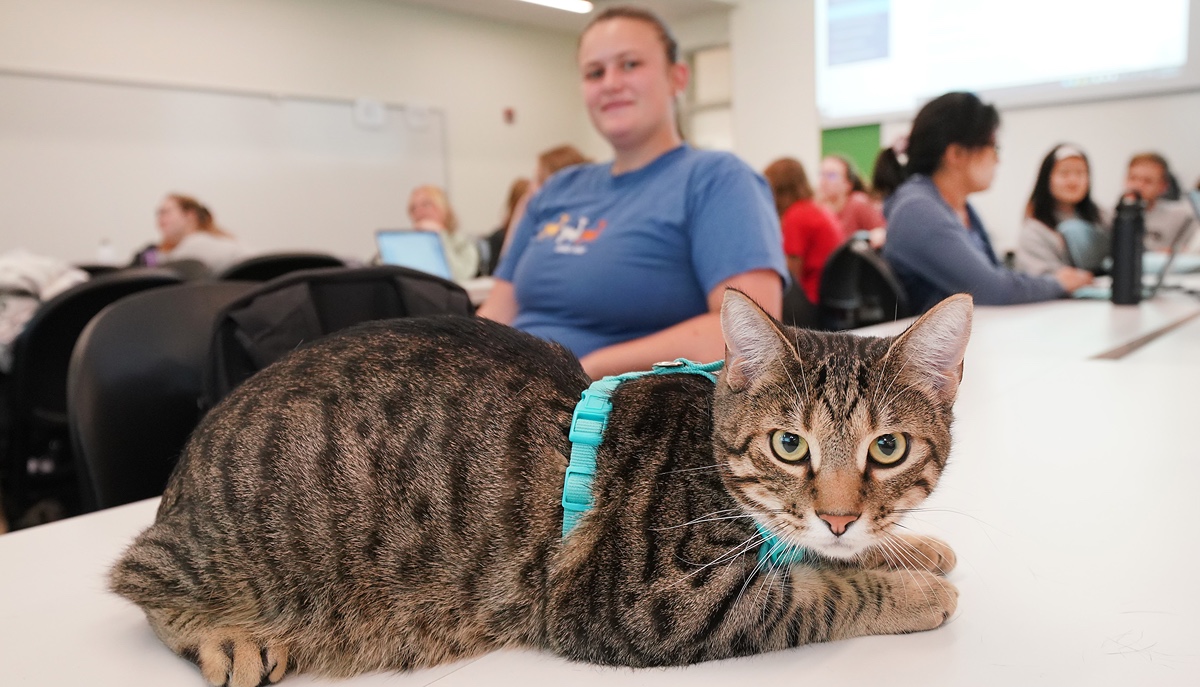
MIkel Delgado, a senior scientist at Purdue University’s School of Veterinary Medicine, has had house cats for most of her life, so she was excited when her new kittens did something her previous cats never did: play fetch. The three cats, sisters adopted from a shelter, all brought her toy mice to throw and then ran to get them.
“It was an interesting surprise,” Delgado said. “It’s very sweet.”
That got her thinking: Was retrieving really such an unusual behavior in cats? So Delgado dug into the research with her Purdue colleagues Judith Stella, senior scientist, and Candace Croney, professor and director of the Center for Animal Welfare Science, and James Serpell of the University of Pennsylvania School of Veterinary Medicine. Using data Serpell had previously collected, they looked at how frequently cat owners reported retrieving and tried to figure out what traits made cats more or less likely to retrieve.
Their analysis found that more than 41% of cats retrieve, compared to about 78% of dogs. In both cats and dogs, younger male cats were more likely to retrieve. Poor health and living with dogs made retrieving less likely in cats and dogs.
The survey data included 8,224 cat owners and 73,724 dog owners.
Some of the results were expected. Certain breeds of dogs are known to be more likely to retrieve, particularly those bred for retrieving or herding tasks – Golden Retrievers, Labrador Retrievers, German Shepherds, etc. – and the team’s analysis confirmed this. These dogs are used to working with people and enjoy the interaction. Breeds that are difficult to train – for example, Great Pyrenees, Chihuahuas and Greyhounds – are less likely to retrieve.
As previous studies have suggested, cat breed also has an influence on retrieving. For example, breeds from the Far East, such as Burmese, Siamese and Tonkinese, retrieve more often than domestic long-haired cats.
“It’s much harder to explain,” Delgado said. Dogs were bred to help humans in various ways, but cats were bred primarily for their looks and companionship.
“Some people say cats have snuck into our hearts without us doing much for them and we haven’t changed them much,” she said. “We don’t ask cats to fetch our slippers, herd sheep or protect our homes.”
One hypothesis is that cats that retrieve are more social, which could explain breed differences. “Siamese cats are very interested in people,” Delgado said.
Indoor cats retrieve much more frequently than outdoor cats. That may be because indoor cats have fewer opportunities to hunt and retrieving scratches the same itch, Delgado said.

The team’s findings were published in the journal PLOS One on September 2. The article is cheekily titled “Retrieving: Distribution and characteristics of retrieving behavior in domestic cats (Felis catus) and dogs (Canis familiaris)” – a reference to the classic comedy “Mean Girls!”.
Delgado said research shows that cats do indeed have social bonds with humans.
“Bringing a toy to us is a social request,” Delgado said. “Many people mistakenly portray cats as aloof or independent, and in truth, they really enjoy these interactions with their owners.”
QUICK FACTS ABOUT FETCH
- About 41% of cats and 78% of dogs retrieve.
- The cat breeds most likely to retrieve include Abyssinians, Bengals, Siamese and Siberians.
- The dog breeds that most commonly retrieve include Labradors, Golden Retrievers, Border Collies, Australian Shepherds, German Wirehaired Pointers and English Cocker Spaniels.
- Both male and female cats retrieve more often than male cats.
- Younger animals retrieve more often.
- Living with a dog reduces the retrieving work for both cats and dogs.
About Purdue University
Purdue University is a public research institution demonstrating excellence at scale. Ranked among the top 10 public universities and with two colleges in the top four in the United States, Purdue discovers and disseminates knowledge at a quality and scale that is unmatched. More than 105,000 students study at Purdue University in all modalities and locations, including nearly 50,000 in person at the West Lafayette campus. Purdue University’s main campus is committed to affordability and accessibility, freezing tuition for 13 consecutive years. Learn how Purdue never stops taking the next big step—including its first comprehensive urban campus in Indianapolis, the Mitch Daniels School of Business, Purdue Computes, and the One Health initiative—at https://www.purdue.edu/president/strategic-initiatives.
Media contact: Devyn Ashlea Raver, [email protected]
Sources: Mikel Delgado, [email protected]
Agricultural communication: Maureen Manier, [email protected], 765-494-8415
Journalist assets: Pictures and/or videos, , Google Drive
